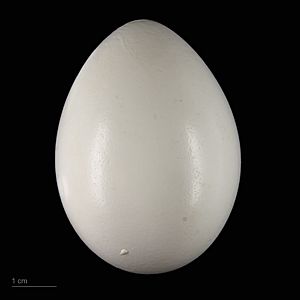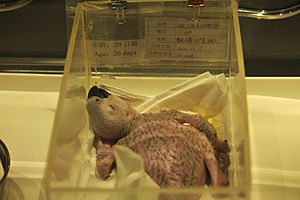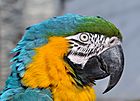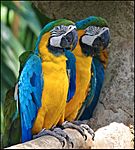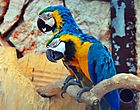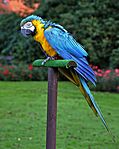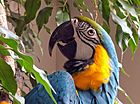Blue-and-yellow macaw facts for kids
Quick facts for kids Blue-and-yellow macaw |
|
|---|---|
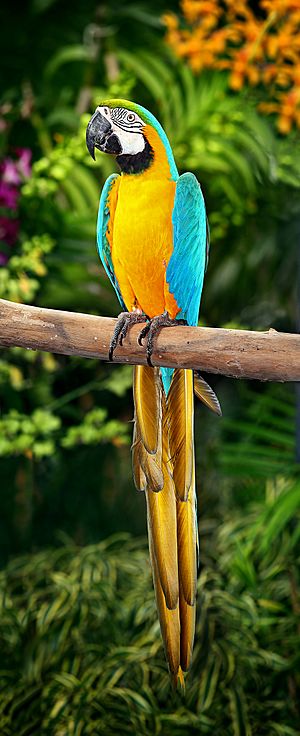 |
|
| Male | |
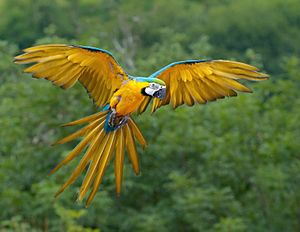 |
|
| Female Both at Jurong Bird Park |
|
| Conservation status | |
| Scientific classification | |
| Genus: |
Ara
|
| Species: |
ararauna
|
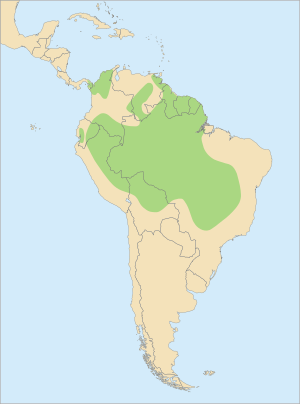 |
|
| Distribution | |
| Synonyms | |
|
Psittacus ararauna Linnaeus, 1758 |
|
The blue-and-yellow macaw (Ara ararauna) is a large, colorful parrot from South America. People also call it the blue-and-gold macaw. It has bright blue feathers on its back and light yellow or orange feathers on its belly. Its head has pretty green colors. This bird is part of a big group of parrots called macaws. You can find them in forests, woodlands, and grassy areas in warm parts of South America. Many people like to keep them as pets because of their beautiful colors, their ability to talk, and how they can bond with humans.
Contents
About Their Name
The blue-and-yellow macaw got its official name in 1758. A Swedish scientist named Carl Linnaeus first described it. He put it in a group with other parrots and gave it the name Psittacus ararauna. Later, in 1799, another scientist created the group Ara just for macaws. The name Ara comes from a Brazilian language called Tupi. It means "macaw" and sounds like the noise these birds make. The second part of its name, ararauna, also comes from Tupi. It means "big dark parrot".
What They Look Like
These amazing birds can grow to be about 30 to 34 inches (76 to 86 cm) long. They usually weigh between 2 and 3.3 pounds (0.9 to 1.5 kg). Their top feathers are a bright aqua blue, but their head is a cool lime green. Their belly is a rich, deep yellow or light orange. They have a black beak and black feathers under their chin. Their feet are gray, with black claws.
The blue-and-yellow macaw has white skin on its face. There are only a few black feathers on its face, which form stripes around its eyes. Their eyes have pale yellow centers. These macaws can live for 30 to 35 years in the wild. They are ready to have babies when they are 3 to 6 years old. Sometimes, their belly feathers can look more orange or "butterscotch" colored. This is often seen in birds from places like Trinidad.
A blue-and-yellow macaw uses its strong beak for many things. It can crack open tough nutshells. It also uses its beak to climb trees and hang upside down. Besides nuts, they eat seeds, fruits, plants, bark, and leaves. They also enjoy insects, snails, and small animals.
Where They Live
You can find blue-and-yellow macaws in many South American countries. These include Colombia, Venezuela, Peru, Brazil, Bolivia, Ecuador, and Paraguay. They also live a little bit in Central America, mainly in Panama. Most of these birds live in wild forests. However, some have started nesting in cities, using dead palm trees along roads.
Sadly, these macaws almost disappeared from Trinidad in the 1970s. But people started a program to bring them back. Between 1999 and 2003, wild macaws were moved from Guyana to Trinidad. This helped them start new families in a protected area. Even so, some groups still say they are gone from Trinidad. You can also find small groups of these macaws in Puerto Rico and Florida, USA. These birds came from ones that were introduced there.
How They Have Babies
Blue-and-yellow macaws usually stay with the same partner for their whole lives. They make their nests mostly inside dead palm trees. The female macaw usually lays two or three eggs. She sits on the eggs for about 28 days to keep them warm. When the chicks hatch, usually one chick grows stronger and gets most of the food. The other chicks might not survive. The baby birds leave the nest about 97 days after they hatch. The male bird's colors show if he is ready to breed. Brighter colors mean he has a better chance of finding a mate.
Protecting Them
The blue-and-yellow macaw is almost gone in Paraguay. But in most of South America, there are still many of them. Because of this, a group called BirdLife International says they are of "Least Concern". This means they are not in immediate danger of disappearing. However, trading them is limited by CITES Appendix II rules. Scientists think there are between 100,000 and 200,000 blue-and-yellow macaws living in the wild today.
As Pets
Even if they are well cared for, blue-and-yellow macaws can be very loud. They might "scream" to get attention or make other loud noises. Loud calls and chewing on things are normal behaviors for them, even when they are pets. Because they are big birds, they need a lot of space to fly around. The World Parrot Trust suggests that a macaw's cage should be at least 50 feet (15 meters) long if possible.
Macaws that are kept as pets, with good food, exercise, and vet care, can live for 60 years or even longer. People who want a macaw as a pet need to know this. The bird might even live longer than its owner!
Blue-and-yellow macaws can show their feelings by blushing. Their bare skin on their face can turn red, and they might fluff up the feathers on their cheeks and head. This happens when they are interacting with humans. It's a way for them to show how they feel.
Gallery
-
Sleepy couple at Weltvogelpark Walsrode (Walsrode Bird Park, Germany)
See also
- List of macaws
- In Spanish: Guacamayo azul y amarillo para niños



